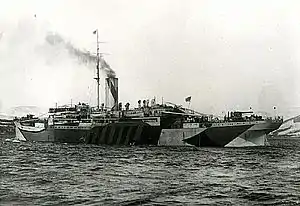HMS Bayano (1913)
HMS Bayano, built in 1913, was originally a banana boat for the Elders & Fyffes line. At the outbreak of World War I it was drafted into the Royal Navy on 21 November 1914 as an armed merchant auxiliary cruiser.[2] On 11 March 1915, it was torpedoed by SM U-27 and sank within minutes killing around 200 of its crew.[2] Twenty-six survivors were pulled from the water.[3]
 HMS Bayano with dazzle camouflage | |
| History | |
|---|---|
| Name: | Bayano |
| Operator: | Elders & Fyffes, Ltd., Glasgow |
| Builder: | Alexander Stephen and Sons, Ltd., Glasgow |
| Launched: | 19 April 1913 |
| Completed: | 1913 |
| Name: | HMS Bayano |
| Operator: | Royal Navy |
| Fate: | Torpedoed by SM U-27 on 11 March 1915 |
| General characteristics [1] | |
| Tonnage: | 5,948 GRT |
| Speed: | 14 knots |
| Armament: | 2 x 6 inch guns |
Background
Once in the Royal Navy she was part of the 10th Cruiser Squadron.[2]
Sinking
In the North Channel on her Glasgow to Liverpool route at 05:15 on 11 March 1915, HMS Bayano was attacked by the German submarine SM U-27 about ten miles (16 km) west of Corsewall Lighthouse, Corsewall Point, Galloway, Scotland.[2][3] The auxiliary cruiser sank in just five minutes and took the commander, Commander H. C. Carr, and 194[4] other crew members down with it. Most of the crew was asleep and only 26 men survived to be rescued by the British steamer Castlereagh.[3] Bayano's Lieutenant Commander Guy described Captain Carr on the bridge, standing without fear waving goodbye while shouting "Good luck to you boys" before the ship disappeared under the waves.[3]
Residents of the Isle of Man were greatly affected by the sinking as a number of bodies washed up on her shores.[5] The funeral procession for the Bayano victims numbered in the thousands even though the victims were not from the island.[5] The Dominion of Newfoundland, then a part of the British Empire, was also hard hit. A dozen men from the Newfoundland Royal Naval Reserve were lost on the Bayano.[6]
Baralong incidents
SM U-27 (Germany) was attacked and sunk in the Western Approaches in position 50°43′N 07°22′W by gunfire from Q-ship HMS Baralong. Her entire crew, including Bernhard Wegener, was killed in the so-called Baralong incidents.[7]
Notes
- Helgason, Guðmundur. "Ships hit during WWI: HMS Bayano". German and Austrian U-boats of World War I - Kaiserliche Marine - Uboat.net. Retrieved 12 March 2015.
- Merseyside Roll of Honour 2010
- Johnston 2015
- Corkill, Adrian. Hostile Sea. p. 21. ISBN 9780954011529.
- Smith 2015, p. 29
- Hadley 1996, p. 251
- Bridgland 1999, pp. 20–55
References
- Bridgland, Tony (1999). Sea Killers in Disguise: The Story of the Q-ships and Decoy Ships in the First World War. Leo Cooper. ISBN 9780850526752.
- Hadley, Michael L., Robert Neil Huebert & Fred W. Crickard (1996). Nation's Navy: In Quest of Canadian Naval Identity. McGill-Queen's University Press. ISBN 9780773515062.
- Johnston, Willie (12 March 2015). "Centenary of HMS Bayano disaster off the Galloway coast". BBC News. Retrieved 12 March 2015.
- Osborne, Richard; Spong, Harry & Grover, Tom (2007). Armed Merchant Cruisers 1878–1945. Windsor, UK: World Warship Society. ISBN 978-0-9543310-8-5.
- Merseyside Roll of Honour (2010). "H.M.S. Bayano". mroh. Retrieved 12 March 2015.
- Smith, Caroline (2015). Isle of Man in the Great War. Pen and Sword Books. ISBN 9781783831227.